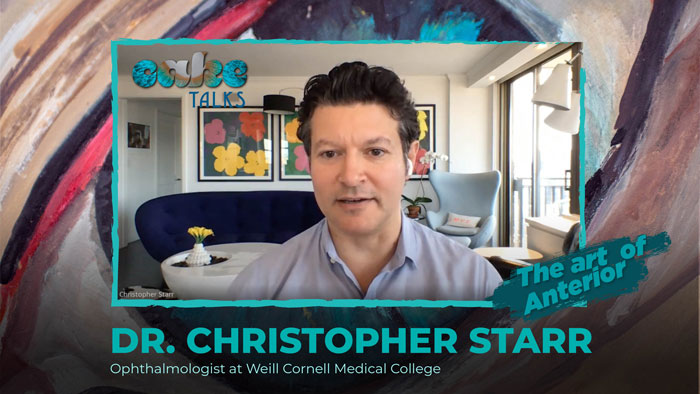Continuing the Art of Anterior video series, CAKE magazine CEO Matt Young caught up with New York City-based ophthalmologist Dr. Christopher Starr during the recent American Society of Cataract and Refractive Surgery (ASCRS 2020) Virtual Annual Meeting.
Connecting the Art & Science of Ophthalmology
The “Art of Ophthalmology” is the theme for the latest CAKE and PIE magazines — and indeed, there are many ways to draw ties between the art and science of eye surgery. Ophthalmology is a visual field in more ways than one, said Dr. Starr. “What we do is very different from other subspecialities: Our diagnoses are largely based on what we see.”
In addition, he said that many ophthalmologists are artists in some form as well, be it painting, music or other forms of art: “I think we tend to be very visually stimulated people.”
And for now, with pandemic-related closures, virtual visual stimulation (and simulation) may be all that some doctors see. So, how are surgeons keeping their surgical skills sharp during these times?
“Being out of the OR for as long as we have, you do worry a little bit about losing some skill in even the most mundane surgeries that we do,” he said. “Watching ASCRS virtually, looking at surgical videos . . . certainly I think those are great ways of staying sharp. You can watch a video and put yourself (almost) realistically in the operating room, at that microscope, in that eye.”
“I’ve been watching all the symposiums and videos and you know, it really does kind of simulate being in the OR — thinking as if you’re in that surgery and what you would do,” added Dr. Starr.
Adjusting to Virtual Visits
Of course, annual meetings aren’t the only thing that’s gone digital: Increasingly, doctors are conducting virtual visits with patients.
Dr. Starr said that adopting telemedicine and virtual visits may be easier for ophthalmologists as most are already quite technically savvy and the field is already heavily reliant on technology.
“At first, we thought that there was nothing we could do [virtually] because we needed a slit lamp, indirect ophthalmic scope, IOL masters, topographies and all of this other super high-tech stuff that we rely on daily,” said Dr. Starr. He says that technology, combined with the newer apps and good Internet bandwidth, can result in a “pretty darn good” consultation, even though it can’t replace an in-person visit.
“Considering you’re not face-to-face with the patient, you can pick up a lot of things — certainly ocular surface conditions, vision changes, eye movement, among others. There’s a lot of things we can glean from a video visit that I wouldn’t have thought possible until I started doing it,” explained Dr. Starr.
“There are also a lot of new technological apps for checking vision and measuring refractions, and great high resolution cameras on phones and computers — so, images can be taken and analyzed. You can do an awful lot without being in the office, and I think that’s going to be the new norm going forward,” he added.
At his office at Weill Cornell Medicine (New York, USA), Dr. Starr said that video visits are a large component of their reopening plan. “We’re going to have dedicated time each day, instead of seeing patients in the office we’re going to have video visit times every day of the week.”
Telemedicine: The New Normal

So, while telemedicine has been a necessary part of continued medical care for many patients during the pandemic . . . when the world finally emerges from this, will these virtual visits stick around?
Dr. Starr answers with a definitive “yes.”
“It’s here to stay, no doubt about it. We are going to be living in a new era post-COVID . . . and I think it’s been a big eye opener for all of us, the whole world. Virtual care is going to become a standard of care for a lot of us; it’s not going to ever fully replace being in person — obviously we still have to do surgery, we still have to see people for certain things — but we’re going to be doing a whole lots of virtual visits,” he said, adding that as the technology improves, it will get better and better. “I find it to be very intriguing, very fascinating, and I certainly hope to help innovate it to some degree in this field going forward.”
Editor’s Note: The American Society of Cataract and Refractive Surgery Virtual Annual Meeting (ASCRS 2020) was held on May 16-17. Reporting for this story all took place at ASCRS 2020 Virtual.



